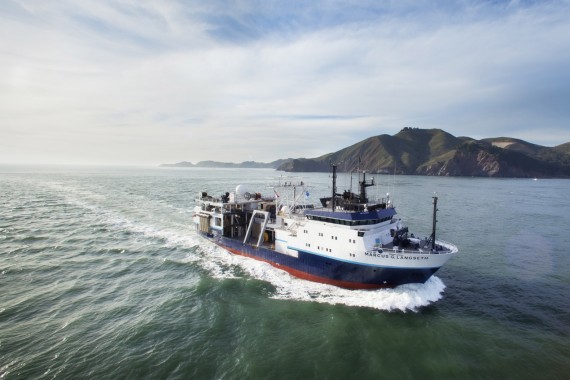R/V Marcus G. Langseth: Expanding Scientific Knowledge of Our Planet
The R/V Marcus G. Langseth, a research vessel operated by Lamont-Doherty Earth Observatory, traverses the world’s oceans conducting marine seismic studies that contribute to new understanding of Earth systems. The ship typically spends half the year or more on research expeditions led by Lamont scientists and colleagues from other research institutes.

Lamont’s research vessel, the Marcus G. Langseth, serves as the national seismic research facility for the United States academic research community.
During June and July, Lamont marine seismologist Donna Shillington and colleagues Dale Sawyer and Julia Morgan of Rice University led an international team of scientists on a cruise conducting seismic surveys in the Deep Galicia Basin of the northeast Atlantic Ocean. The goal of their project is to learn more about the birth of the Atlantic, which likely began forming about 200 million years ago.
The group collected the first-ever three-dimensional (3D) seismic imaging data needed to study the distinctive continental-to-oceanic crustal transition in the Deep Galicia Basin, located about 200 miles off the coast of northern Spain. Using sound waves, the team created a 3D image of the rocks in the Deep Galicia Basin. The new datasets resulting from this expedition will improve understanding of how continents stretch and break apart, creating new ocean basins in between.
While at sea, Shillington, Lamont graduate student James Gibson, and others shared life and work aboard the Langseth through a website and blog.
Following the Galicia cruise, the Langseth headed to the north Atlantic Ocean for a month-long cruise led by scientists from the University of Hawai’i at Manoa, including marine geophysicist Fernando Martínez (Ph.D. ’88), and Iceland’s Institute of Earth Sciences. The goal of the month-long cruise was to collect multibeam, magnetic and gravity data that will inform understanding of the evolution of the Reykjanes Ridge, a segment of the Mid-Atlantic Ridge just south of Iceland. This data set will be used to test competing theories about what’s happening in this geologically unusual hotspot-dominated ridge, with important implications for our understanding of geodynamic processes in the Earth.
Visit the Marine Operations section of the Lamont website to learn more about the R/V Langseth and the Observatory’s long history of seagoing exploration and discovery.